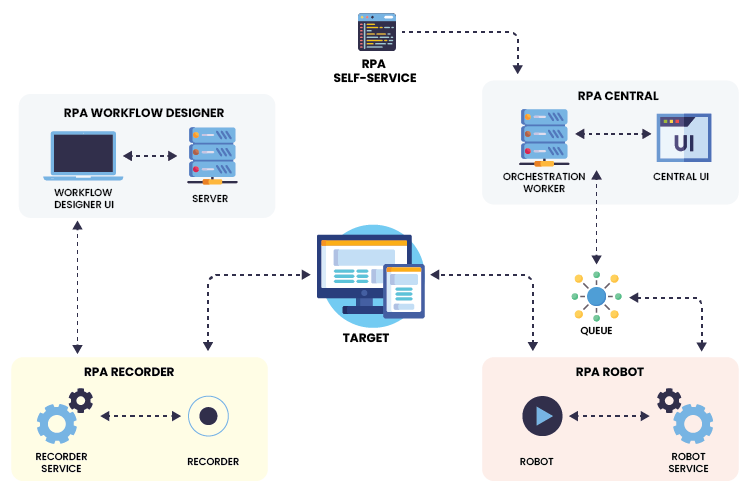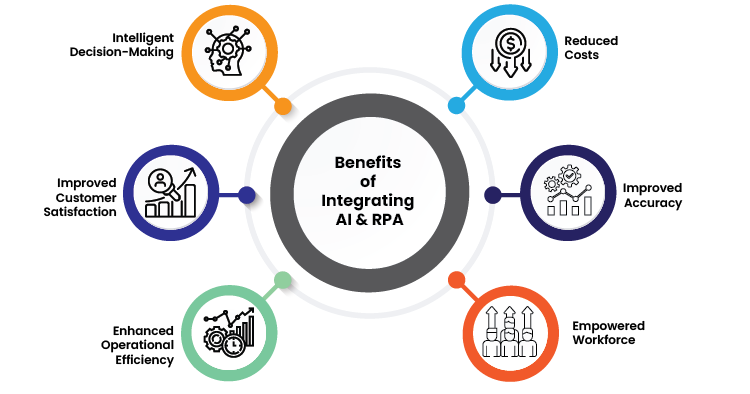

ACL Digital
AI-Powered RPA Unveiled: How It Works and Why It Matters
In today’s fast-paced business landscape, efficiency and innovation are at top. Organizations are constantly looking for techniques to modernize operations, reduce costs, and improve productivity. Enter AI-powered Robotic Process Automation (RPA), a groundbreaking technology that is transforming the way businesses operate. By combining the precision of RPA with the cognitive capabilities of artificial intelligence, AI-powered RPA offers a powerful solution for automating complex tasks, improving accuracy, and freeing up human resources for more strategic activities. In this blog, we will delve into the mechanics of AI-powered RPA, explore its significant impact across various industries, and explain why it is becoming an indispensable tool for forward-thinking enterprises. Join us as we unveil the intricacies of AI-powered RPA and discover how it is reshaping the future of work.
Understanding RPA (Robotic Process Automation)
Robotic Process Automation (RPA) is a revolutionary technology that leverages software robots, or “bots,” to automate repetitive, rule-based tasks typically handled by humans. By mimicking human interactions with digital systems, RPA enables businesses to streamline operations, reduce errors, and increase efficiency.
Key Components of RPA
Robotic Process Automation (RPA) is built on several key components that enable the automation of repetitive tasks. These components work together to streamline operations, reduce errors, and enhance productivity across various business functions.

Bots
The core of RPA, bots are software applications designed to perform specific tasks. These tasks can range from simple data entry to more complex processes like invoice processing or customer service interactions.
RPA Software
This is the platform that allows users to design, deploy, and manage bots. Popular RPA software includes tools like UiPath, Automation Anywhere, and Blue Prism. These platforms offer a range of features such as drag-and-drop interfaces, integration capabilities, and analytics.
Workflow Design
This involves creating a sequence of tasks for the bots to execute. Workflow design can be done through visual interfaces provided by RPA software, making it accessible even to those without extensive programming knowledge.
Integration
RPA systems need to integrate with existing IT infrastructure, including databases, applications, and other enterprise systems. This ensures seamless operation and data flow across the organization.
The Role of AI in RPA
Artificial Intelligence (AI) is revolutionizing RPA by enhancing its capabilities and expanding its applicability. While traditional RPA focuses on automating rule-based, repetitive tasks, AI-powered RPA (often referred to as Intelligent Automation or Cognitive RPA) brings advanced cognitive functions to automation processes. This integration allows RPA to handle more complex tasks that involve decision-making, understanding unstructured data, and continuous learning. Here, we explore the key roles AI plays in transforming RPA.
Enhancing Data Processing
AI significantly enhances data processing capabilities within RPA by enabling the handling of unstructured data. AI-driven data analysis uncovers patterns and insights, providing a deeper understanding and more informed decision-making in automated workflows.
Handling Unstructured Data
Traditional RPA is effective with structured data, but many business processes involve unstructured data such as emails, documents, images, and audio files. AI technologies like Natural Language Processing (NLP) and Optical Character Recognition (OCR) enable bots to understand, extract, and process information from these unstructured sources. For example, AI can read and interpret the content of emails to trigger appropriate responses or actions.
Data Analysis and Insights
AI can analyze large datasets to uncover patterns, trends, and insights that are beyond human capacity to discern quickly. Machine learning algorithms can identify anomalies, predict future trends, and provide recommendations, enhancing the decision-making process within automated workflows.
Cognitive Capabilities
AI endows RPA with cognitive capabilities, enabling bots to understand and process human language, learn from data, and interpret visual information. Computer vision further enhances bots’ ability to perform tasks requiring visual verification, making AI-powered RPA adept at managing complex and dynamic processes.
Natural Language Processing (NLP)
NLP allows bots to understand and generate human language. This capability is crucial for tasks such as sentiment analysis in customer feedback, processing natural language commands, and automating interactions with chatbots. AI-powered RPA can thus handle customer service inquiries, translate languages, and summarize text, significantly improving customer engagement and operational efficiency.
Machine Learning (ML)
ML enables bots to learn from data and improve over time. By analyzing historical data, machine learning models can make predictions and decisions without being explicitly programmed for every scenario. This is particularly useful for tasks like fraud detection, risk assessment, and personalized customer recommendations.
Computer Vision
Computer vision allows bots to interpret and process visual information from the physical world. This capability can be applied to tasks such as quality control in manufacturing, inventory management, and automated document processing where visual verification is required.
Decision-Making and Predictive Capabilities
AI augments RPA by providing bots with sophisticated decision-making and predictive abilities. This enables bots to analyze data and make informed decisions based on set criteria and learned patterns, such as evaluating loan applications or prioritizing customer inquiries. Machine learning-driven predictive capabilities allow bots to forecast trends and identify potential issues, such as anticipating equipment failures or detecting fraudulent activities. These enhancements elevate RPA from a rule-based tool to a dynamic, proactive system
Intelligent Decision-Making
AI enhances RPA by enabling bots to make intelligent decisions based on predefined criteria and learned patterns. For example, in loan processing, AI can evaluate applicant information and make approval recommendations based on risk profiles and historical data.
Predictive Maintenance
In industries like manufacturing, AI-powered RPA can predict equipment failures by analyzing sensor data and historical maintenance records. This proactive approach reduces downtime and maintenance costs by enabling timely interventions.
Learning and Adaptation
AI enables RPA bots to continuously learn and adapt, enhancing their efficiency and effectiveness over time. Reinforcement learning allows bots to optimize their actions by receiving feedback from their environment, ensuring they adapt to changes and maintain high levels of accuracy and reliability in dynamic business environments. This ongoing learning process transforms RPA into a flexible and resilient automation solution.
Self-Learning and Improvement
AI allows RPA systems to continuously learn from their experiences and adapt to new data and scenarios. Reinforcement learning techniques enable bots to optimize their actions based on feedback and changing conditions. This self-improvement capability is crucial for maintaining efficiency in dynamic environments.
Context Awareness
AI enables bots to understand the context of their tasks and make more informed decisions. For instance, in customer service, AI can provide agents with relevant information about a customer’s history and preferences, leading to more personalized and effective interactions.
Practical Applications of AI in RPA
AI in RPA automates complex tasks across industries, such as enhancing customer service with intelligent chatbots, streamlining document processing with OCR and NLP, and optimizing supply chain operations through demand prediction and automated order processing. These applications improve efficiency, accuracy, and decision-making in business processes.
Customer Service Automation
AI-powered RPA can handle complex customer inquiries by understanding the context and intent of the conversation. Chatbots and virtual assistants equipped with NLP can resolve issues, provide product recommendations, and escalate cases to human agents when necessary.
Document Processing
AI enhances document processing by reading and extracting information from invoices, contracts, and forms. Intelligent bots can validate data, match it with existing records, and update systems without manual intervention.
Fraud Detection
In the financial sector, AI-powered RPA can analyze transaction patterns to detect and prevent fraudulent activities. Machine learning models can identify suspicious behaviors and flag them for further investigation.
Healthcare
AI-enabled bots can process patient records, assist in medical automation and diagnostics by analyzing medical images, and manage appointment scheduling. This automation reduces administrative burdens and enhances patient care.
Supply Chain Optimization
AI can predict demand, optimize inventory levels, and automate order processing. This leads to more efficient supply chain operations and reduces the risk of stock outs or overstock situations.
Benefits of AI-Enhanced RPA
AI-enhanced RPA offers numerous benefits, including increased efficiency and cost savings by automating complex tasks and reducing the need for human intervention. It improves accuracy and reliability by minimizing errors in data processing and decision-making. The scalability of AI-powered RPA allows it to handle growing workloads and adapt to changing business needs. Additionally, it enhances customer experience through more personalized and efficient services, ultimately driving higher satisfaction and loyalty. These advantages make AI-enhanced RPA a powerful tool for optimizing business operations.

Increased Efficiency
AI extends the capabilities of RPA, allowing for the automation of more complex and varied tasks, which boosts overall productivity and efficiency.
Cost Reduction
By automating higher-order tasks and reducing the need for human intervention, organizations can achieve significant cost savings.
Improved Accuracy
AI reduces the likelihood of errors in data processing and decision-making, leading to more reliable and accurate outcomes.
Scalability
AI-powered RPA can handle increasing volumes of tasks and adapt to evolving business needs, making it highly scalable.
Enhanced Customer Experience
By providing more personalized and efficient services, AI-powered RPA improves customer satisfaction and loyalty.
The integration of AI with RPA transforms the scope and capabilities of automation, enabling businesses to tackle more complex tasks, make better decisions, and drive innovation. As AI technologies continue to advance, the synergy between AI and RPA will unlock new possibilities for automation, leading to smarter and more agile enterprises.
In the rapidly evolving landscape of business automation, AI-powered RPA stands out as a transformative force, redefining how organizations operate and compete. By combining the efficiency of RPA with the intelligence of AI, businesses can automate complex processes, enhance decision-making, and drive innovation.
ACL Digital is at the forefront of this revolution, offering cutting-edge AI-powered RPA services that help businesses unlock their full potential. With a deep understanding of industry needs and a commitment to delivering tailored solutions, ACL Digital empowers organizations to streamline operations, reduce costs, and achieve unprecedented levels of productivity. Whether it’s automating customer service interactions, processing large volumes of data, or optimizing supply chain management, ACL Digital’s expertise ensures that businesses can harness the power of AI-enhanced RPA to stay ahead of the curve. Contact us at business@acldigital.com for more detail or go through our enterprise automation offerings.
Related Insights


Long Short Term Memory Networks: What It Is and How It Works?

Journey with Machine Learning towards MLOps

A Deep Dive into How Annotation Works in Machine Learning

Data Augmentation and its Importance in Machine Learning

